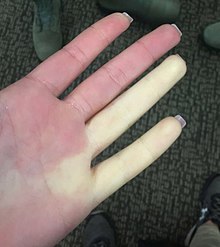
Back ظاهرة رينو Arabic Reyno fenomeni Azerbaijani راینود سندرومی AZB Fenomen de Raynaud Catalan Raynaudova nemoc Czech Raynaud-Syndrom German Σύνδρομο Ρεϊνό Greek Fenómeno de Raynaud Spanish سندرم رینود Persian Raynaud’n oire Finnish
| Raynaud syndrome | |
|---|---|
| Other names | Raynaud's, Raynaud's disease, Raynaud's phenomenon, Raynaud's syndrome[1] |
 | |
| The hand of a person with Raynaud syndrome during an attack. | |
| Pronunciation | |
| Specialty | Rheumatology |
| Symptoms | An affected part turning white, then blue, then red, burning[2] |
| Complications | skin sores, gangrene[2] |
| Usual onset | 15–30 year old, typically females[3][4] |
| Duration | Up to several hours per episode[2] |
| Risk factors | Cold, emotional stress[2] |
| Diagnostic method | Based on the symptoms[3] |
| Differential diagnosis | Causalgia, erythromelalgia[5] |
| Treatment | Avoiding cold, calcium channel blockers, iloprost[3] |
| Frequency | 4% of people[3] |
| Named after | Maurice Raynaud |
Raynaud syndrome, also known as Raynaud's phenomenon, is a medical condition in which the spasm of small arteries causes episodes of reduced blood flow to end arterioles.[1] Typically the fingers, and, less commonly, the toes, are involved.[1] Rarely, the nose, ears, nipples, or lips are affected.[1] The episodes classically result in the affected part turning white and then blue.[2] Often, numbness or pain occurs.[2] As blood flow returns, the area turns red and burns.[2] The episodes typically last minutes but can last several hours.[2] The condition is named after the physician Auguste Gabriel Maurice Raynaud, who first described it in his doctoral thesis in 1862.[6]
Episodes are typically triggered by cold or emotional stress.[2] Primary Raynaud's is idiopathic (spontaneous and of unknown cause) and not correlated with another disease. Secondary Raynaud's occurs as a result of some other condition and has an older age at onset; episodes are intensely painful and can be asymmetric and associated with skin lesions.[3] Secondary Raynaud's can occur due to a connective-tissue disorder such as scleroderma or lupus, injuries to the hands, prolonged vibration, smoking, thyroid problems, and certain medications, such as birth control pills and stimulants.[7] Diagnosis is typically based on the symptoms.[3]
The primary treatment is avoiding the cold.[3] Other measures include the discontinuation of nicotine or stimulant use.[3] Medications for treatment of cases that do not improve include calcium channel blockers and iloprost.[3] There is little evidence that alternative medicine is helpful.[3] Severe disease may in rare cases lead to complications, specifically skin sores or gangrene.[2]
About 4% of people have the condition.[3] Onset of the primary form is typically between ages 15 and 30 and occurs more frequently in females.[3][4] The secondary form usually affects older people.[4] Both forms are more common in cold climates.[4]
- ^ a b c d "What Is Raynaud's?". nhlbi.nih.gov. US: National Heart, Lung, and Blood Institute, National Institutes of Health. 21 March 2014. Archived from the original on 4 October 2016. Retrieved 1 October 2016.
- ^ a b c d e f g h i j "What Are the Signs and Symptoms of Raynaud's?". nhlbi.nih.gov. US: National Heart, Lung, and Blood Institute, National Institutes of Health. 21 March 2014. Archived from the original on 5 October 2016. Retrieved 1 October 2016.
- ^ a b c d e f g h i j k l Wigley FM, Flavahan NA (11 August 2016). "Raynaud's Phenomenon". The New England Journal of Medicine. 375 (6): 556–65. doi:10.1056/nejmra1507638. PMID 27509103.
- ^ a b c d "Who Is at Risk for Raynaud's?". nhlbi.nih.gov. US: National Heart, Lung, and Blood Institute, National Institutes of Health. 21 March 2014. Archived from the original on 5 October 2016. Retrieved 1 October 2016.
- ^ Barker RA (2005). The A-Z of Neurological Practice: A Guide to Clinical Neurology. Cambridge University Press. p. 728. ISBN 9780521629607. Archived from the original on 24 April 2017.
- ^ Koehler U, Portig I, Hildebrandt O, Koehler NA (December 2019). "Maurice Raynaud (1834-1881) and the Mystery of 'Raynaud's Phanomenon'". Dtsch Med Wochenschr (in German). 144 (25): 1778–1783. doi:10.1055/a-0869-9899. PMID 31847013. S2CID 209409136. Archived from the original on 28 November 2022. Retrieved 4 October 2023.
- ^ "What Causes Raynaud's?". nhlbi.nih.gov. US: National Heart, Lung, and Blood Institute, National Institutes of Health. 21 March 2014. Archived from the original on 4 October 2016. Retrieved 1 October 2016.
© MMXXIII Rich X Search. We shall prevail. All rights reserved. Rich X Search